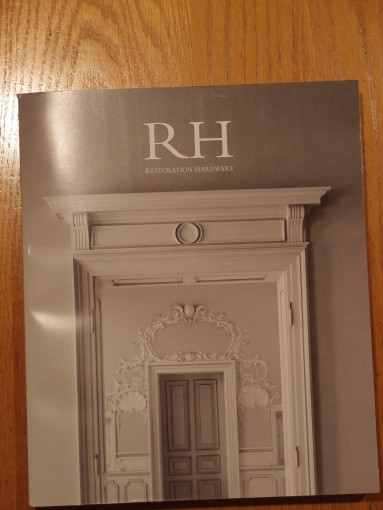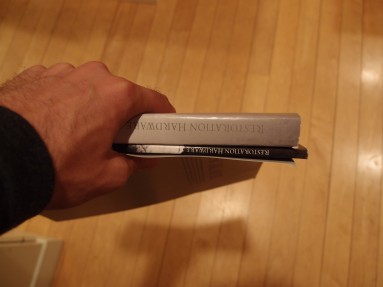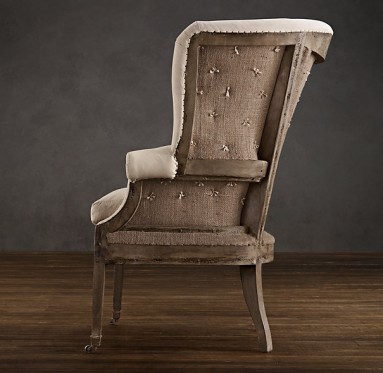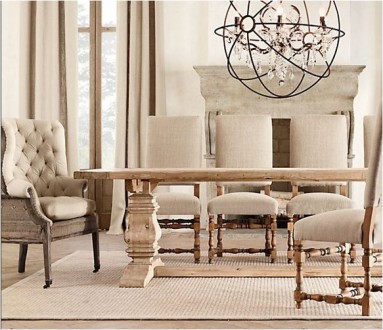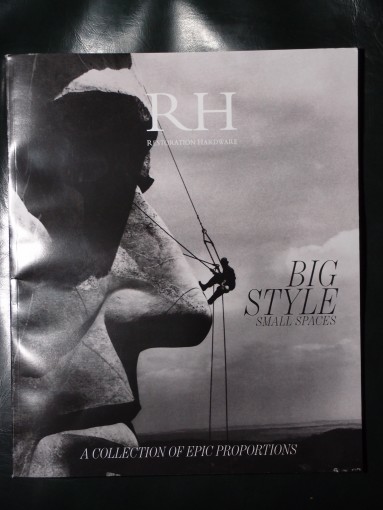PROJECT INTRODUCTION
Yesterday, there was something in the mailbox for me. Something enormous, unexpected, unrequested, and ghastly.
It is called the Restoration Hardware Fall 2012 Sourcebook. Until this moment, I didn’t know what a Restoration Hardware is. For starters, it is very large.
It involves three pieces, one of which is 690 pages of paper, one is 154, and the third is only one free floating page but makes reference to how ecologically sound the collective existence of the other 744 pages is. Currently without the kind of scale on which one might weigh marijuana or robin feathers, I am limited to estimating, but it feels about the weight of one human hand and the majority of a forearm. A large hand, a large arm.
Judging by the sheer dazzling size of the object, I assumed that I had, whilst drunk one evening, resubscribed to Art Forum - in order to stay up on the advertising formats and fonts currently preferred by the art world - which alone could explain a chunk of shiny paper that size appearing in the mailbox, threatening to collapse the whole thing beneath its obscene heft. Alas, I haven’t been drunk for a while. Stranger, still: the address to which this thing came is one I barely use anymore, in a town and state where I no longer live. As for what prompted the decision to send such an arcane mass, I can only imagine that Restoration Hardware is self-authorizing and self-propelling, rather like the murderous robot in Richard Stanley’s underwatched, cyberpunky, and appropriately named - for this instance, at least - 1990 film Hardware: an autonomous assemblage of bile and cunning that roams the earth looking for energy sources and, in the case of the Restoration model of the Hardware, domestic spheres to infiltrate and decimate.
Since it arrived, I have learned what it is, because I read it. It’s rather like the Abercrombie catalog that used to get a lot of attention, except that instead of waxed teens rubbing their hipbones together, there are very expensive furnishings that have been rubbed with other objects - such as sandpaper and poor people - to make them look “worn.”
I had started a project a while back to compile a “black book” that would record the ongoing demolition of this species and its built world, grouped around the figure of the metropolis. That proved, not surprisingly, to be rather overambitious, although the file swells. However, I may abandon even that, as I found it already has been done for me. This is it. Albeit in reverse. It is a catalog not only of gently weathered chairs constructed from fuselage, but a catalog of all that should be struck from the record of history. Not that it’s not without its uses: the solvency of the company, not to mention its capacity to print this thing, is single-handed proof of the necessity of abolishing capital.
It is also, not coincidentally, the nightmare of salvagepunk: not an unbinding of material qualities from the value form, but the binding together of mediated ruination with value production. By that binding, I mean a “deconstructed 19th c. English Wing Chair”: “inspired by classic 19th-century seating but liberated from adornment and updated for comfort. A distressed solid walnut frame is complemented by the rich texture of sand linen and burlap, accented with whipstitching and nail heads.”
(I had to look up whipstitching as well: it is often used for joining together felt. It leaves a lot of visible stitches and looks “like crap”.) Not mentioned but visible are the tears that have been torn in them, as if they had been passed down through generations, rather than cooked in a yuppie kiln over a hell fire. The Deconstructed 19th c. English Wing Chair in Sand Belgian Linen with Burlap retails for $1795, with a matching French Napoleonic Ottoman (Catalog and Web Only) for $695 or $795, depending on size.
By that binding, I mean also a “Trestle Salvaged Table” in “salvaged black finish”: “handcrafted of unfinished 100-year-old solid reclaimed pine timbers from buildings in Great Britain. Rough-hewn planks are carefully hand-selected, planed, and sanded, yet
It is also, coincidentally, as if history vomited in its mouth and breathed it back down into its lungs.
Also, while we are on the topic, I forgot to mention that the Trestle Salvaged Wood Dining Table is available not only in Salvaged Black, but also Salvaged Natural and Salvaged Brown, and its cost ranges from $1795 (also known as “1 Deconstructed 19th c. English Wing Chair in Sand Belgian Linen with Burlap”, an awkward contemporary unit of exchange) to $3495, which can seat up to 14 people.
As if that wasn’t a big enough problem, there is this:
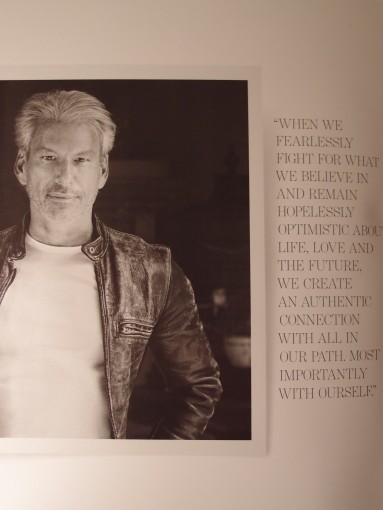
The this in question was their CEO. His name is Gary Friedman. He’s a total fucking tool, obviously. But he has good stubble, I’ll give him that. He’s not the CEO anymore because although he is 54 years old, he somehow managed to win the heart of a 26 year old employee. No easy task, but again, there’s that stubble, and his jacket isn’t bad, although not as good as the stubble. Also, in his opening letter to the sourcebook, he quotes Don Quixote, which is always a good move, especially when you are trying to impress an employee of yours. However, because this joyous union of souls was not to the liking of the shareholders, Mr. Friedman resigned, although rumor has it that the relationship has continued, proving what everyone knew all along, that love knows no bounds.
And this:
which urges that “we are of the opinion that bigger is not always better”, although we know that such a statement should not cast doubt or aspersion on the God-given talents of Mr. Friedman, and which stages its tumors as lifestyle options, including “MILAN APARTAMENTO” and “AUSTIN BUNGALOW” knowing that somewhere, a couple will indeed say, Yes, baby, let’s go RIVER NORTH ROW HOUSE. All the fucking way. It doesn't matter that we live in east LA. Fuck geographical specificity. Heterochrony is the new local. No shame, no regrets, no doubts.
And, for the final kick in the teeth of thought, regard the dazzling courage known as this:
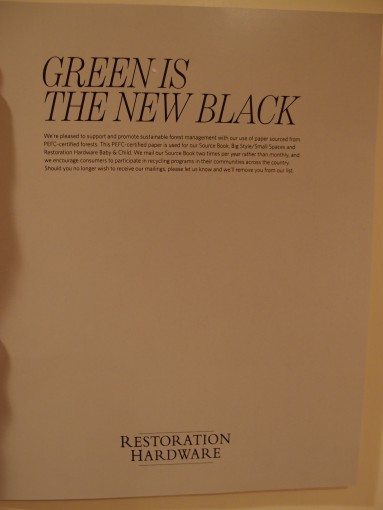
It may be hard to read, so I’ll spell it out. It says that green is the new black, which is a clever - and extremely rare - play on words regarding the way in which black is seen as the perennial “in style” color, meaning that it is now “in” to be green. And Restoration Hardware wants us to know that they “support and promote sustainable forest management with our [their] use of paper sourced from PEFC-certified forests.” They further reassure us that they mail their “Source Book two times per year rather than monthly, and we [they] encourage consumers to participate in recycling programs in their [our] communities across the country.” Also, they will remove us from their list if we do not want to receive their “mailings.”
When I started writing that paragraph, I didn't know where it would end, but I loosely envisioned I would have a snide comment to conclude it, in which I’d pretend to act like printing 744 pages of sheer hatred was in fact a good use for a forest that had been PEFC-certified, as was using the extra sheet and ink to tell us this fact. But I don’t have a joke now. Because it isn't exceptional. Rather, it's the typicality of the whole thing, even if ramped up to slightly more visible excess here, that is nauseating. In place of a joke: Gary Friedman catches fire. Inside a a “Circa 1900 French Locker,” “constructed of steel with a burnished finish.” Catches fire sustainably, of course.
What to do with this hostile gift I received? I, being someone who devotes a lot of his time to trying to understand the link between capital, horror, the built world, and social forms, all understood as historically particular and shifting relations, can’t exactly turn away from something this evil, this located at the center of all those forces and tendencies. Sometimes objects pick us, rather like the cube in Hellraiser, if that cube had been burnished and smudged to look like it was found in a warehouse on the docks of Marseille.
So I’ve decided to do the only reasonable thing I can think of: to produce a constrained writing gothic horror on the basis of the Restoration Hardware Fall 2012 Sourcebook, trapped within its confines. There are 158 tableaus, each of which features a specific product. Some show the product alone, framed against the dark, but the vast majority depict it amongst other products arranged in a living space: bedroom, bathroom, living room, dining room, office, kitchen. These 158 tableaus will therefore constitute the 158 rooms of the house - the Restoration House - in which this horror is set. Each room makes up one chapter, in which the prime source of antagonism - at times a monster, at times not - is the product described at the top of the page beside the photo. No plot has been or will be decided beforehand, and although I read through the catalogue to get a sense of what it was and to count its tableaus, I haven’t sketched out where the story will go on the basis of what rooms and items are to come. It will be dictated by the ordering that their marketing department had decided would be the most successful.
Within those rooms, the narrative can develop as I wish,
And so we begin...

